The following are from the students of Erling Solberg in the Tertnes Upper Secondary School in Bergen, Norway. Thank you for your very interesting questions.
Question 1: Are the instruments you are using for this cruise special and developed solely for this expedition, or are similar instruments being used by other researchers as well? Answer: None of the instruments we are using were designed specifically for this cruise. The Acoustic Doppler Current Profilers (ADCPs) used for measuring currents have been used on many other oceanographic projects. It’s the same with the Microcat CTDs which are attached to the mooring wire and measure the conductivity, temperature and depth of the water. Both of these can be bought commercially. The other main instrument we are using on the moorings is a Coastal Moored Profiler (CMP). The CMP is a device that travels up and down the wire several times a day to collect salinity (saltiness) and temperature information. This instrument was designed and developed at WHOI, but it, too, has been used on other projects. 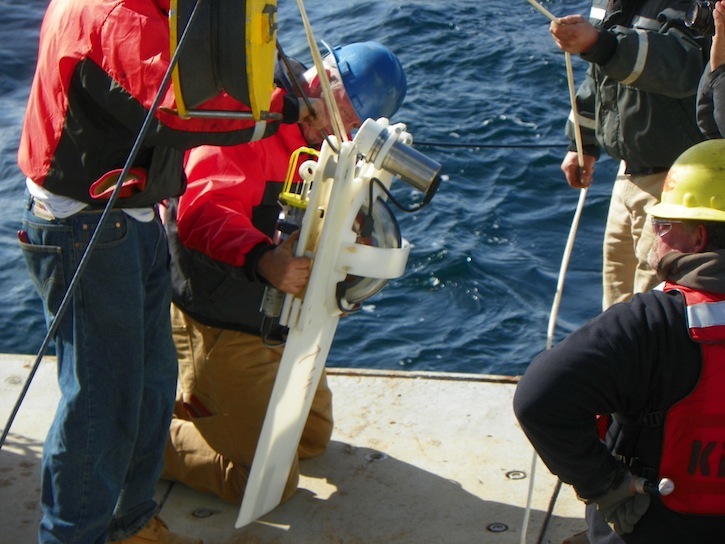
Mooring Tech Jim Ryder adjusts the Coastal Moored Profiler (CMP) on the mooring wire. © Pat Keoughan (See Ben’s video on the website called “Oceankit”.) Answered by Dan Torres, Physical Oceanography Research Associate Question 2: Is the data you gather processed and analyzed aboard the KNORR, or is it sent to scientists on shore for analysis, or is it, perhaps, analyzed after the cruise? There are two answers to this question: The first has to do with the twelve moorings that were deployed across the Denmark Strait at the beginning of our cruise. These instruments will remain anchored to the bottom of the Strait for a year. They will collect and store data on the direction and speed of the current as well as the salinity and temperature of the water. Another research cruise will return next year, retrieve the moorings and get the stored data transferred to the computers on board. The data will then be analyzed for years at the scientists’ institutions. (See Ben’s video on the website on moorings.) 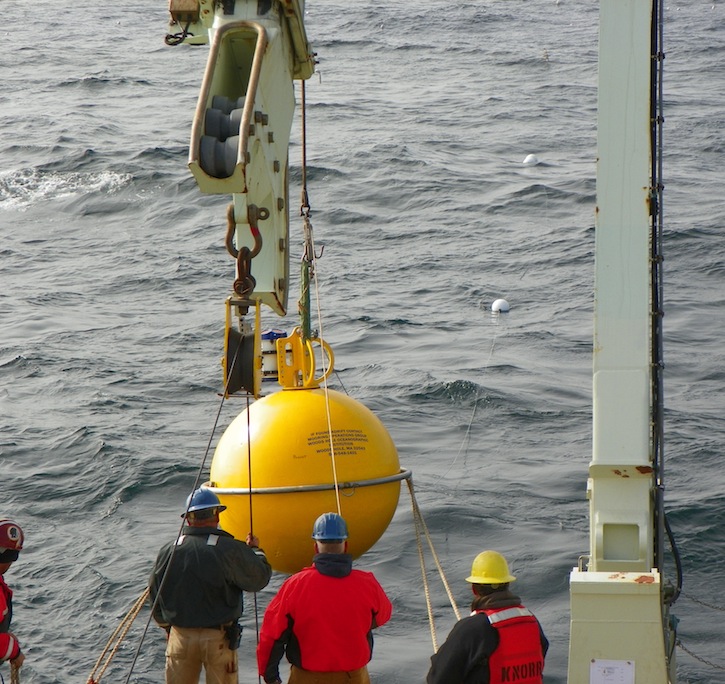
The Top Float, which will hold its mooring vertical in the water above the anchor, is readied to go over the transom into the Denmark Strait. © Pat Keoughan The second answer to the question deals with the hundreds of CTD casts being done throughout this cruise. Data is sent electronically from the CTD to computers onboard throughout the cast. Water is collected during the cast and analyzed to compare to the electronic data. Within a brief time the scientists are able to see the results. 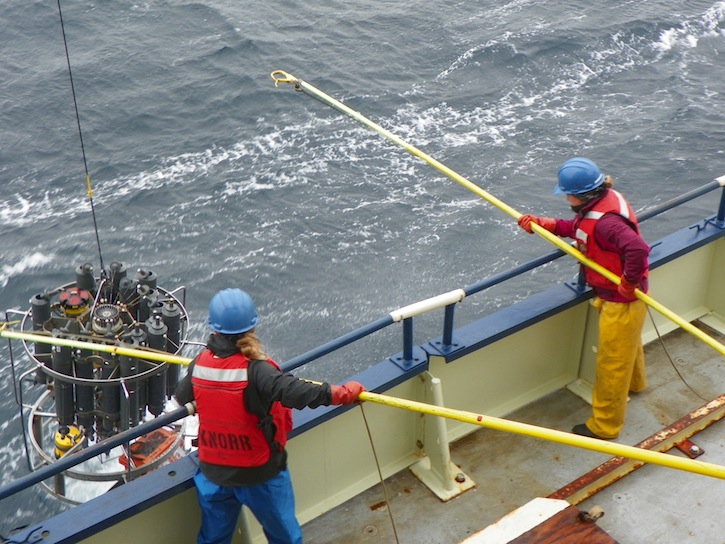
Stephanie Zamorski and Lena Shultze get ready to clamp on tag lines to steady the CTD as the winch raises it out of the water at the end of a cast. © Pat Keoughan Answered by Pat Keoughan, Outreach Team Question 3: What reason did you have for exploring the Denmark Strait? (Did you have reason to believe there was a new current there?) Answer: The science team responsible for this trip aboard the Knorr did indeed know there was a new ocean current. An Icelandic scientist aboard during the early part of the cruise, Hedinn Valdimarsson, was one of the two discoverers of this new current known as the North Icelandic Jet (NIJ). The scientists have a hypothesis that this new current contributes up to half of the cold water going through the Denmark Strait and therefore must play an important role in our climate processes. The reason for putting moorings across the Denmark Strait was to collect the data to analyze in order to measure and identify the water going through the Strait. They want to see how much of it is from the NIJ and how much from the East Greenland Current, to prove or disprove their hypothesis. This will not be accomplished during only one cruise. (Ben mentions the purpose of this cruise in his first video on the website.) Answer from Co-discoverer of the North Icelandic Jet, Hedinn Valdimarsson, on how the NIJ was discovered. We did not have an idea about the new current. It was the first time we were out there with a vessel mounted ADCP and measuring the inflow of Atlantic water to the area north of Iceland, that we saw this current. So indeed we were looking at something else in the beginning. After we measured the current for two consecutive trips with year between, and with some reference to older data we were able to go out with the news of the new current. The older data was partly a current measurement further west and CTD data that we had. Later we tried to extend the studies further by tracing the current using CTD data further east, and we put a current meter out there for a year. All of these were confirming this current more and more. Finally, of course, the LADCP observations (ADCP’s lowered on CTD’s aboard an Icelandic research vessel) and dense CTD's (casts close to each other) that were brought in by our co-workers at WHOI showed a clearer picture and extended the knowledge of what we named the North Icelandic Jet. (Edited for English by Pat Keoughan) 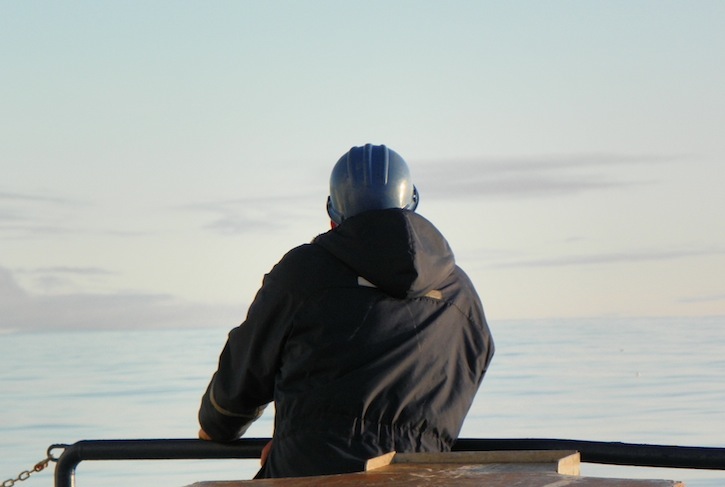
Hedinn Valdimarsson, codiscoverer of the North Icelandic Jet, looks out over the stern of the KNORR at the Denmark Strait. © Pat Keoughan Answered by Pat Keoughan Question #4 Are the currents through the Denmark Strait newly discovered, or have there been any theories about these currents before? Answer: I have reread a few of Dallas’s journals on our website to help me answer your question. People have known about the Denmark Strait and it’s currents for a long time. There was an accepted process describing where the cold water in the strait came from. Then in 1996, Cecilie Mauritzen, a graduate student at the joint program between MIT and WHOI proposed the scheme as we understand it today when she published a paper about it. Her theory stated that most of the cold water in the Strait originated from the East Greenland Current. Now our team of scientists hypothesis is changing Mauritzen’s idea somewhat by considering the flow of cold water from the NIJ in addition to the East Greenland Current to make up the current in the Denmark Strait. (There is a diagram of these currents in Dallas’s 12th Journal on the website.) 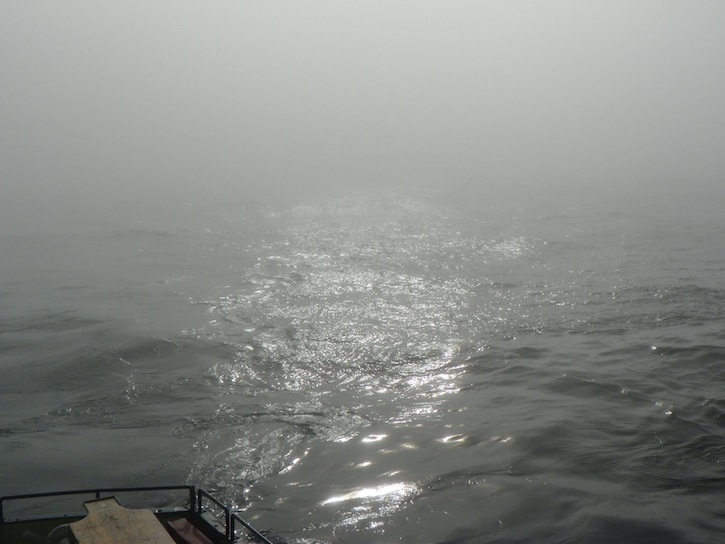
Sun and fog compete in the Denmark Strait. © Pat Keoughan Answered by Pat Keoughan Question#5: Can this newly discovered current effect the climate in Norway in any way? Answer: This new current, the North Icelandic Jet, is a very important part of our climate system. So, we can say that it does have an influence on the climate in Norway. An important consideration is that now that we know about this new current, there are new questions about our understanding of the role these currents play in the North Atlantic climate processes, which the NIJ is part of, that affects the countries surrounding it. For example, how sensitive is it to changes in climate? On this cruise and others in the future we will be working to learn more about the NIJ and to better understand its influence on our climate system. 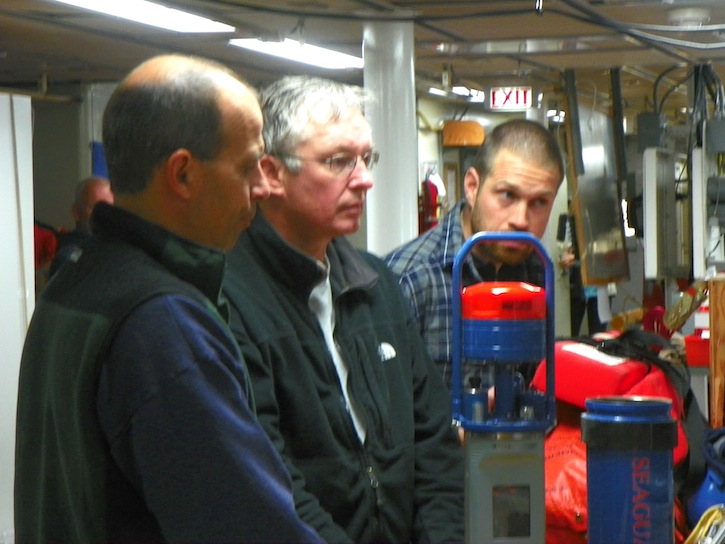
Scientists Bob Pickart, Hedinn Valdimarsson and Kjetil Vage in the KNORR's main lab. © Pat Keoughan Answered by Kjetil Vage, Physical Scientist
Last updated: December 27, 2011 | |||||||||||
Copyright ©2007 Woods Hole Oceanographic Institution, All Rights Reserved, Privacy Policy. | |||||||||||


